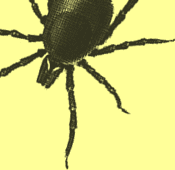

Tick-borne Encephalitis is a communicable disease caused by a flavi-virus, infected ticks being the main vectors. At least 10.000 cases of TBE are referred to hospitals each year, yet the incidence of TBE is so far not fully recognized. The nervous system is affected, at least four clinical features of different severity are observed: meningitis, meningoencephalitis, meningoencephalomyelitis, meningoradiculoneuritis.
Hospitalisation varies between days and months; some cases need many years of treatment and rehabilitation measures.
Just recently one patient died after two years of coma. A 20 year old male patient developed a severe TBE after being biten by a tick in an endemic region. He was not vaccinated. He stayed for inpatient treatment (9 months) in three different hospitals, survived in a apallic syndrome and finnaly died two years after onset of TBE. (Binder L.: Frühsommer-Meningoenzephalitis (FSME) in Österreich: Übersicht über Erkrankung und Impfung mit Fallbericht (In: H.Mittermayer, M.Pietsch (Hrsg.): Impfmanagement - Qualitätssicherung in der Prävention. 2. Erweiterte Auflage, 1998)
In Austria TBE used to be the most important viral disease affecting the central nervous system; this situation has changed due to the impact of vaccination.
No specific therapy for TBE is known so far.
TBE can only be diagnosed accurately by means of laboratory techniques, as the clinical symptoms are usually not specific for the disease.
TBE has become an international public health problem also because of increasing mobility of people travelling to risk areas.
Austria has gained a lot of experience by trying to control TBE and should be able to support other countries to establish and expand their own efforts.
TBE is very easily prevented by vaccination.
TBE is much easier to be prevented than the other tick borne disease namely Lyme-Borreliosis.
Social Marketing including public awareness campaigns is necessary to create problem awareness towards TBE
Information measures are needed to reach as well the general public as the professional community; international efforts should be able to supplement the necessary local information measures.
New epidemiological projects could be performed on an European level by following up the hypothesis of underestimating the impact of TBE.
TBE could serve as an example of international cooperation
Which helps to control a preventable disease which is underestimated in Europe
Which allows the rapid dissemination of accumulated know how regarding vaccination programmes and public health aspects of a communicable disease
Which is very much related to occupational risk situation on the one hand by also to mobility of people on the other hand
Activities to control TBE on the level of the European Community therefore would create a considerable public health benefit.